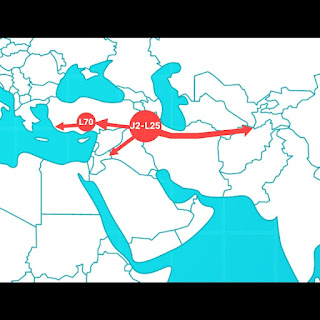J2-L25 is the second most frequent type of J2 in Armenia (~5%). It is found in Central Asia, from Iran to Europe, in North Africa and Mesopotamia. It is rare in Caucasus. The age of L25 is 9100 year old. It seems all modern L25 descend from one Neolithic farmer who lived in northwestern Iran, southeastern parts of historic Armenia and in north Mesopotamia. The oldest L25 we have is from Tepe Hissar (5500 year ago) in north Iran. L25 was prominent among Iran related farmers but was completely absent among Anatolian and Levantine related farmers.
- PF4888, L243 A low frequence branch found in Near East and Europe. One ancient sample was found from Roman era Boghazkoy in Anatolia.
- F3133 This is the biggest subclade of L25. It migrated to east from NW Iran. It was found in ancient South Central Asia. In Bronze Age BMAC culture. It was also found in east Iran, Jiroft culture. In most likelihood it was present in Harappa also but still no direct prove of that. F3133 has good presence in Iraq. Based on that it was suggested that it can be a Sumerian marker, but still no hard evidence of that. After the arrival of Steppe people in Central Asia (Andronovo) the Proto Iranian community formed as a mixture of Andronovo and BMAC which resulted in the integration of some F3133 in Proto Iranian community. Indeed few cases of F3133 were found among ancient Scythians, Saka and Turkic samples. But most of Armenian cases of F3133 do not belong to this Scythian branch and their presence in Armenia is almost certainly old.
- Z438, Z387, L70 This branch has a very unique history. It is mostly European and eastern Mediterranean. This is not the result of farmer's migration. Rather a Late Bronze Age migration from Anatolia to Italy and subsequent expansion with Roman Empire. How Z438 appeared in Anatolia is not clear yet. It could have migrated from North Iraq/South Armenian Highland to Anatolia in Late Chalcolithic. The age of L70 subclade is 3800 but the star cluster starts at 3400 years ago which can be linked with Late Bronze Age collapse in Near East and migrations of various Sea People. A paper from ancient Rome has found a signal of migration from Anatolia (ancient Armenian samples were used as proxy) in Iron Age during the Early Republican era. But L70 was not present in few ancient DNA published in this paper, while some L70 were present in Imperial Rome period. Despite a migration to Italy the story of L70 almost certainly is not related to the origins of Etruscans. In Lazaridis 2022 significant number of L70 and samples from parallel branches were found from Anatolia. The Y17949 parallel to L70 is unrelated to Sea People story.

Thanks for your analysis. Regarding L70, I mostly agree with your conclusions, although, I think it played a relevant role in ancient Greece as well, either on Myceaneans or in the invasions to the hellenic Peninsula that followed the Bronze Age collapse. It is indeed relevant in southern Italy ( Magna Graecia), and on the Greek islands. Probably classical greek ancient samples will help us to have further information.
ReplyDeleteI share the fact that probably played a role on late Bronze age/ Early Iron age in Italy, and it was indeed spread by romans, specially on western Europe.
Regards